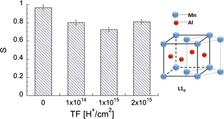Article contents
Radiation effects on the magnetism and the spin dependent transport in magnetic materials and nanostructures for spintronic applications
Published online by Cambridge University Press: 11 February 2015
Abstract

Spintronics utilizes spin or magnetism to provide new ways to store and process information and is primarily associated with the utilization of spin polarized currents in memory and logic devices. With the end of silicon transistor technology in sight, spintronics can provide new paradigms for information processing and storage. Compared to charge based electronics, the advantages of magnetism/spin based devices are nonvolatility and ultra low power. In particular, magnetoresistive random access memories (MRAMs) are known to be “Rad Hard” [HXNV0100 64K x 16 Non-Volatile Magnetic RAM (www.honeywell.com/aerospace), S. Gerardin and A. Paccagnella, IEEE Trans. Nucl. Sci.57(6), 3016–3039 (2010), R.R. Katti, J. Lintz, L. Sundstrom, T. Marques, S. Scoppettuolo, and D. Martin, Proceedings of IEEE Radiation Effects Data Workshop, 103–105 (2009)] and are considered to be critical components for space and military systems due to their very low power consumption and nonvolatility. However, advances in the magnetic nanostructures and new materials for the scalability of MRAM and other potential applications require a re-evaluation of their radiation hardness. This review focuses mainly on recent progress in understanding the effects of irradiation on the magnetic materials and magnetic structures that are related to MRAM technology. Up to date, the most pronounced effects on the microstructures and the properties are linked to the displacement damage associated with heavy ion irradiation; however, the thermal effect is also important as it acts as an annealing process to recover the damage partially. Critical metrics for the magnetic tunnel junctions for postmortem characterizations will also be discussed. Finally, with the introduction of new perpendicular magnetic layers and the very thin MgO barrier layer in the next generation MRAM, the effects of the ionization damage shall be studied in the future.
- Type
- Articles
- Information
- Copyright
- Copyright © Materials Research Society 2015
Footnotes
Contributing Editor: Joel Ribis
References
REFERENCES
- 12
- Cited by




